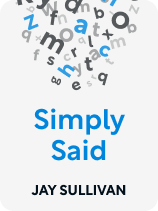

This article is an excerpt from the Shortform book guide to "Simply Said" by Jay Sullivan. Shortform has the world's best summaries and analyses of books you should be reading.
Like this article? Sign up for a free trial here .
Do you write a lot for business or work? What are some things you should keep in mind when writing any kind of business documentation or correspondence?
Writing is a necessary part of any professional field. When it comes to written business communication, you should write in a manner that’s concise, clear, and to-the-point. Nobody likes to waste their time reading long emails that beat around the bush.
Here are some tips on how to write documents and emails that people will actually read.
Professional Communication 101
When it comes to written business communication, the most important rule of thumb to keep in mind is to write with the reader in mind—consider why they’re reading your message and what you want them to do with it, and make it easy for them to understand what you’re saying. He has the following specific tips:
Tip #1: Keep It Short
Sullivan says people are more likely to read a short document than a long one. As a general rule, keep each sentence shorter than 17 words long, but vary your lengths to keep the rhythm interesting. (Shortform note: Other experts recommend an average of 25 words per sentence and add that if you can’t accurately capture your idea within 25 words, don’t be afraid of going longer—clarity is more important than length.)
Also keep paragraphs short—going beyond a quarter of a page for a paragraph can overwhelm your reader. Sullivan says you can trim the fat by:
Eliminating unnecessary words and shortening phrases. For example, replace “the reason for,” with “because” and “despite the fact that” with “although.” (Shortform note: Other words that tend to lengthen text include redundant pairs such as “each and every”; unnecessary qualifiers such as “basically,” “actually,” and “extremely”; and ideas expressed in the negative such as “not accept” instead of “reject” and “not allow” instead of “deny.”)
Using strong verbs in place of weak nouns. Let your verbs do the heavy lifting; read each sentence to see if you’ve clearly expressed the key action in each sentence. Edit out nouns that end in –tion, -ment, –ance, and -ing, and replace them with action words. For example, instead of saying, “This document will help you in the development, implementation, and evaluation of the new system,” say, “This document will help you develop, implement, and evaluate the new system.”
(Shortform note: Strong verbs are generally preferable to nouns because they sound more authoritative and convincing. However, Sullivan doesn’t identify which verbs are considered strong and which ones are weak. Experts say that verbs like “did,” “was,” and “said” don’t make as much of an impact as more descriptive verbs such as “develop,” “assert,” and “define.”)
Tip #2: Use the Proper Voice
You can make your message stronger or soften the blow of bad news with the right voice. Review every sentence to check that you’ve used the appropriate voice:
Active voice: In this case, the actor comes before the verb. (For example: Our department will gather all the data.) It’s generally the preferable form because it’s simpler, stronger, and clearly states accountability.
Passive voice: In this case, the actor is relegated to the end of the sentence or isn’t there at all. Sullivan writes that this voice is often vague and doesn’t have as much of an impact. For example, when you write, “Updates will be emailed weekly,” it’s unclear who will be doing the updating. Sullivan recommends that you use this voice purposefully—for example, when avoiding accountability to soften a message (“Your proposal was rejected”).
(Shortform note: Sullivan’s note about preferring the strong active voice falls within the larger debate about the weakness of the passive voice and the advice to avoid it. Some writers argue that a passive sentence construction can still be strong; for example, Winston Churchill—one of the greatest speakers in history—frequently used passive verbs to great effect. When it comes to communication, the real goal is to simply write clearly and “let the verbs fall where they may.”)
Tip #3: Follow a Format
Sullivan says that documents generally fall into one of two purposes: persuasive or informative. Each one follows a standard format, which saves you a lot of time and effort—you don’t have to reinvent the wheel every time you write a document. Instead, just use a tried-and-tested format, changing the details as needed.
1) Persuasive: This type of writing is meant to convince the reader to take an action or think a certain way. When writing persuasively, Sullivan recommends you:
- Start with the present: Deliver your main message in the first sentence.
- Detail the past: If the reader needs more information, include a paragraph about the history and context of the issue.
- Look to the future: Discuss the benefits of taking action. Conclude with next steps, clearly stating the deadline and the persons involved.
(Shortform note: Sullivan doesn’t cover how to persuade your audience based on their patterns of thinking. In The Culture Map, Erin Meyer offers tips for persuading your audience based on whether they practice applications-first thinking (considering practical solutions to a problem) or principles-first thinking (looking at the reasons behind a problem). She writes that you’ll have better luck persuading applications-first thinkers by sending shorter, concise messages of no more than 125 words. On the other hand, principles-first thinkers will respond more to messages that focus on theory.)
2) Informative: This type of writing is meant to brief the reader about a topic or issue. When writing to inform, Sullivan recommends you follow the presentation format that we discussed in Part 1: Tell them what you’re going to tell them, tell them, then tell them what you just told them.
- Tell them what you’re going to tell them: State the issue, and give a brief background.
- Tell them: Enumerate specific matters that you’ll address in the document (Matter 1, Matter 2, Matter 3, and so on). Then, explain each matter one by one.
- Tell them what you just told them: Summarize what you just said, then clarify the next steps.
(Shortform note: Some experts argue that the triple “tell them” approach may not be effective in every scenario, saying that there can be too much of a good thing—excessively signposting can make your audience feel patronized and impatient. While this generally applies to slides, it helps to review your long documents to make sure that you’re not falling into the trap of perpetual announcement: Check that you don’t keep telling them what’s about to come in the next section.)

———End of Preview———
Like what you just read? Read the rest of the world's best book summary and analysis of Jay Sullivan's "Simply Said" at Shortform .
Here's what you'll find in our full Simply Said summary :
- A blueprint for effective business communication
- How to create and deliver memorable presentations
- How to write documents and emails that people will actually read






